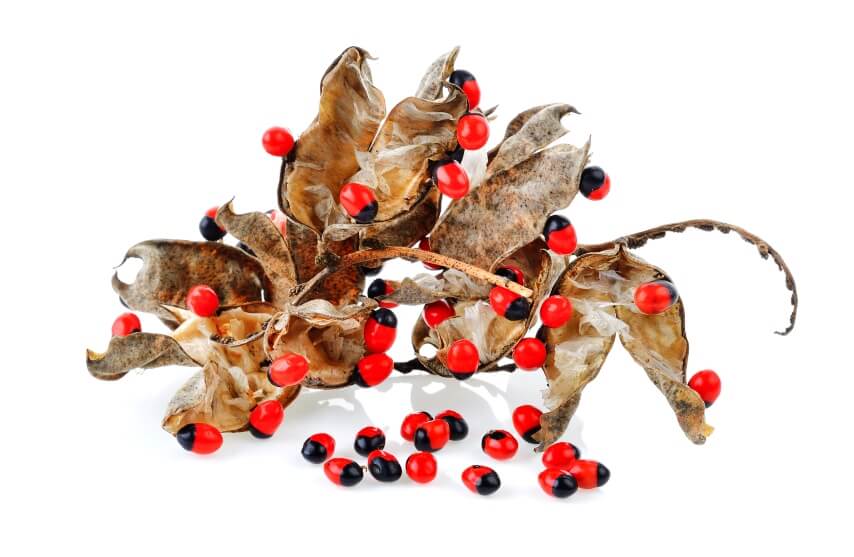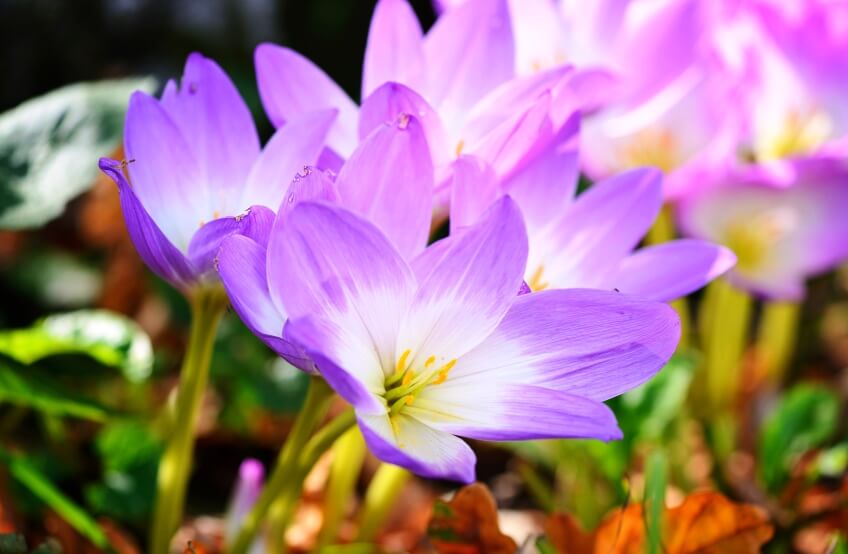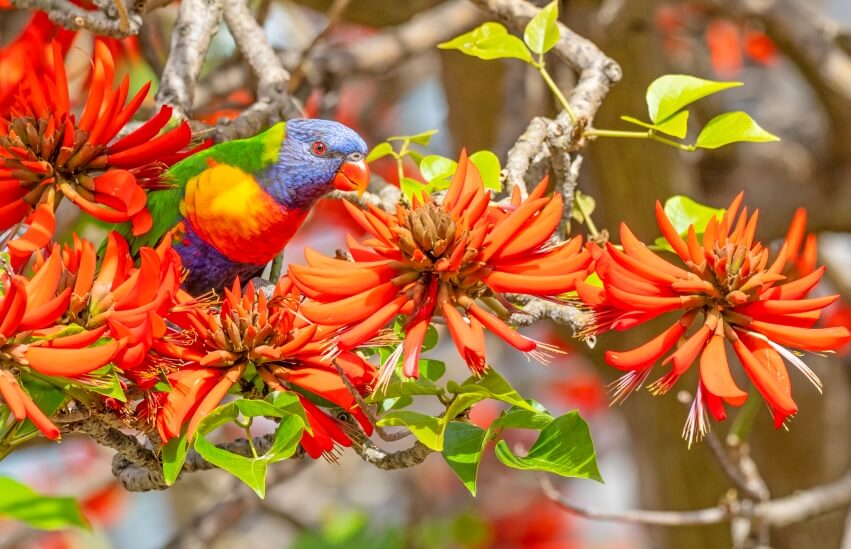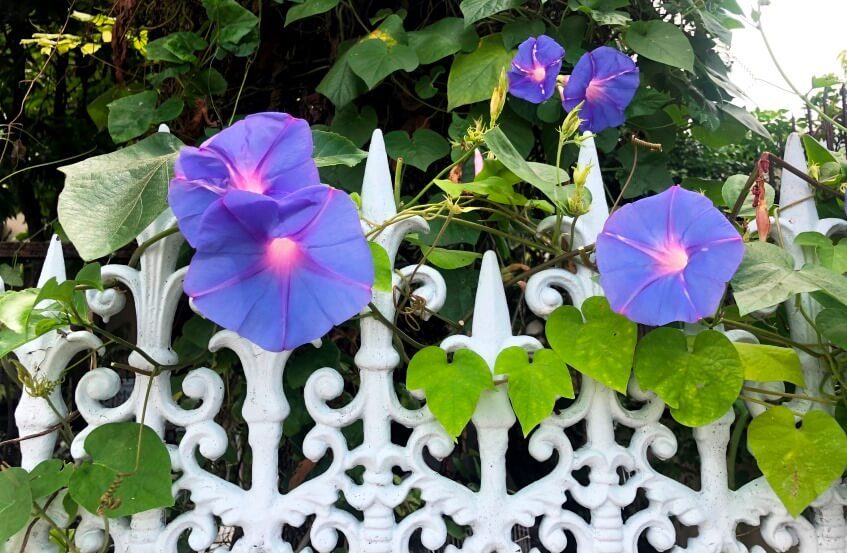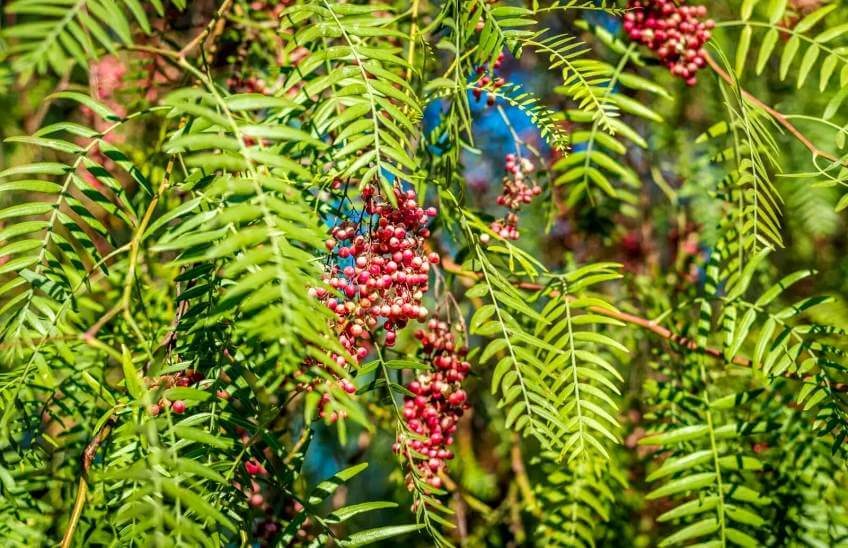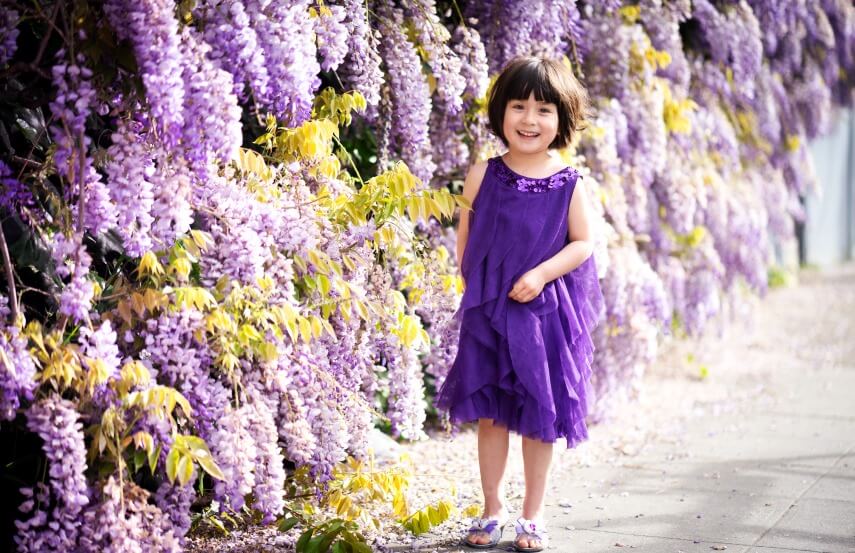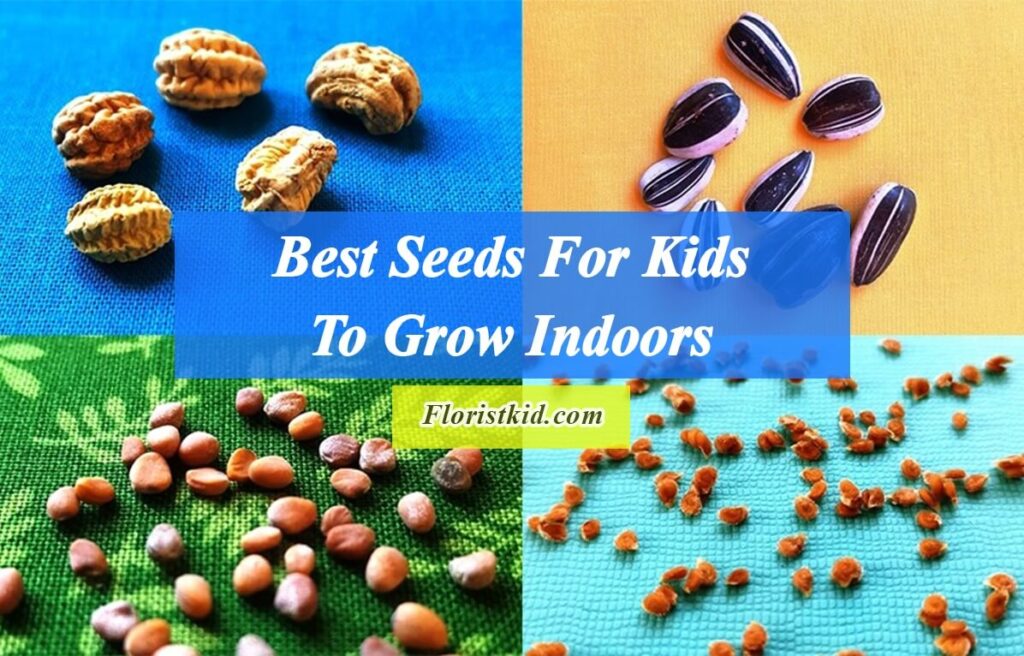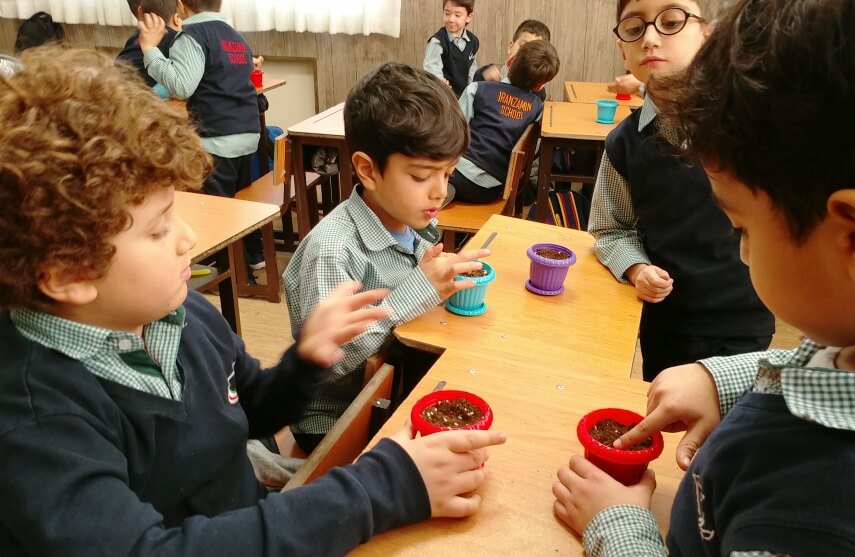Did you know that some plants produce poisonous fruits and seeds that, when consumed by humans or animals, can result in disease or even death? Unfortunately, many of these plants are widely distributed in urban areas and family gardens. The presence of these kinds of plants in our living surrounding can be dangerous as Children may gather these plants’ seeds to plant, while animals may eat others. Knowing poisonous seeds for children, pets, and humans is essential for keeping family gardens free of them.
This post will cover ten typical garden plants with poisonous seeds and fruits to let us know more about these dangerous seeds and plants.
If you are interested in this topic, you can also read
<<Poisonous Plants For Children>> and <<Kid-freindly indoor Plants >> articles.
Poisonous Seeds For Children, pets, And Humans
Abrus precatorius
Common names: Rosary pea, crab’s eye, love pea, lucky bean
This plant has distinctively shaped red seeds with a black spot known as Abrus precatorius beans, sometimes referred to as Rosary peas or Jequirity beans. Rosary pea origins in India and has spread significantly in tropical regions like Florida, the Caribbean, and the Hawaiian islands.
Only the rosary pea seeds are poisonous since they contain strong lectins (toxalbumins) known as abrin I and II that are poisonous to humans and other animals. Eating the seeds of this plant may result in symptoms like nausea, vomiting, abdominal pain, and diarrhea.
Toxic effects and risks
Most Abrus precatorius poisoning cases are reported in young children who consume the tasty peas. However, if the hard seeds are chewed before being swallowed, all animals, including dogs, chickens, other birds, horses, pigs, and ruminants, are susceptible.
When ingested, intact seeds move through the digestive tract without exposing the animal to the lectins they contain. The most significant risk to animals is the seeds which are frequently gathered and taken into homes and become accessible to caged birds, cats, and dogs.
Rosary pea seeds
Caesalpinia
Common names: Peacock flower, Barbados pride, bird of paradise flower, dwarf Poinciana
Caesalpinia has at least 70 species only found in tropical areas of the planet. Species of Caesalpinia are scrambling climbers, shrubs, or trees that frequently have many thorns.
Caesalpinia spike-like flowers are produced from the top leaf axles. They have distinct petals and stamens in red, yellow, or cream colors.
Toxic effects and risks
The Caesalpinia genus contains several poisonous substances, including gallotannins and diterpenoids. The pods and seeds are particularly poisonous. However, the entire plant is poisonous. Gallotannins are strong irritants that can cause severe gastrointestinal problems such as vomiting, colic, and diarrhea.
In warm areas, ornamental Caesalpinia species are popularly grown since they are attractive shrubs and trees. As a result, these plants’ pods and seeds may be consumed by domesticated animals throughout the year.
Colchicum
Common Names: Autumn crocus, meadow saffron, and naked lady.
Colchicum is indigenous to West and Central Asia, North America, and Europe. The Balkans and Turkey’s surrounding Mediterranean region are the origins of many species. Nearly all species generate flowers before they produce leaves.
Its leaves are basal, long, and linear blades. Flowers are often purple, pink, or white and are produced singly or in clusters on top of long tubes. Each Colchicum flower has six stamens and three pistils, contrasting with the three stamens in the Crocus species. While many species prefer to bloom in the fall, others may also bloom in the spring.
Toxic effects and risks
The Colchicum species contains dangerous alkaloids in all of its parts, while the blooms and seeds have the highest quantities. The primary substance is colchicine, a poisonous alkaloid that inhibits cell mitosis.
The harmful effects of colchicine can affect any mammal. Multiple organ failures characterize acute colchicine poisoning. Prolactin, insulin, glucose tolerance, and catecholamine synthesis are all significantly decreased by the presence of colchicine. The glory lily (Gloriosa superba) is another plant known to contain colchicine and other related alkaloids.
One of the most poisonous corms or bulbs accessible to household pets is the colchicine-containing corms of the Colchicum species. The corms are usually sold for indoor flowering, which only requires putting the corm in a container with some water on a windowsill.
In two or three weeks, the beautiful blossoms start to develop. Pets and children in the home easily access the corms in such conditions. When the Colchicum corm is mistaken for wild garlic or the blossoms are eaten, cases of human poisoning happen.
Corynocarpus
Common names: Karaka nut or berry
The tropical regions of New Zealand are the native home of Corynocarpus laevigatus. This plant is a branching tree with huge, leathery, glossy green leaves that can grow to 15 meters. panicle-like inflorescences are formed terminally on branches. Corynocarpus Flowers are greenish white-yellow. The green fruits are ovoid, 5–7 cm long, and turn yellow-orange as they ripen.
Toxic effects and risks
The complex glycoside karakin is a glucose ester of 3-nitroproprionic acid (3-NPA) found in the seeds of this plant. The central nervous system may be impacted by karakin. However, the seeds become edible after being thoroughly cooked, eliminating their toxicity. The flesh of ripe fruits of this tree can be eaten raw, but eating the raw seeds can poison humans and animals.
Since Corynocarpus laevigatus is a rare tree in North America, there is no reason to worry about it. But because it was brought into California, the Gulf Coast, and Mexico, it poses a local threat to children and animals.
source: reddit
Datura
Common names: Moon flower, jimson weed, sacred datura, angel’s trumpet, thorn apple, Indian apple, tolguacha.
Datura species, which have about 25 species worldwide and are native to tropical and subtropical areas, are shrubby herbs, annuals, or perennials with glabrous or pubescent stems and leaves. The stems are up to 4 feet (1.5 meters) tall, upright, and branched. Its leaves are short petioles, ovate, elliptic, or triangular blades.
At the leaf axils, large, showy, and fragrant flowers are produced. The seeds are abundant and have a pitted surface. The fruits are ovoid, spiny capsules that break open when ripe.
Toxic effects and risks
The tropane alkaloids L-hyoscyamine and scopolamine are present in all plant sections. They are especially abundant in the seeds. Scopolamine is more common in the leaves, while hyoscyamine is typically concentrated in the seeds.
Most documented poisoning incidents occur in people who intentionally eat the seeds or make tea from the leaves of moon flower to experience the hallucinogenic effects of the tropane alkaloids. Despite the alkaloids’ hallucinogenic properties, their significant impact on the nervous system can result in fatalities.
The honey produced by bees that primarily consume datura is also poisonous. Datura seeds commonly contaminate the grain that ruminants, horses, pigs, and birds are fed, causing poisoning in those animals. Dogs can occasionally become accidentally poisoned.
source: Taste of home
Erythrina
Common names: Coral tree, coral bean
The tropical regions of the Americas and Africa are home to more than 100 species of Erythrina. The trunks and branches of perennial shrubs and trees are frequently covered in blunt conical thorns.
Three oval to rhomboid leaflets make up the pinnately complex leaves. Inflorescences are big, axillary, or terminal racemes that range in color from brilliant red to orange-yellow. Each flower contains five fused sepals, five petals form a unique banner that resembles a pea and keel enclosing the stamens.
Toxic effects and risks
The various species of Erythrina contain a wide range of distinctive, complex alkaloids. All parts of the plant contain alkaloids, but the blooms and seeds contain the most. All alkaloids are harmful when consumed and predominantly have a curare-like effect, paralyzing the victim. Animals that chew and swallow the seeds carry the alkaloids through their milk.
Since many Erythrina species have eye-catching flowers, they are frequently grown as ornamental shrubs or trees in tropical gardens, parks, and along sidewalks. The bright red seeds pose a risk to kids and animals that might eat, chew, and swallow them. The seeds Erythrina have been used to poison dogs in Mexico. However, there are no known instances of Erythrina poisoning in household pets.
Ipomoea
Common name: morning glory
Morning glories are in flower from early summer until the first October frost. Their trumpet-shaped flowers have heart-shaped leaves and thin stalks and are available in pink, purple-blue, magenta, or white. Their fragrant, vibrant blossoms are not only pleasing to the sight but also a favorite of hummingbirds and butterflies.
Toxic effects and risks
In particular, the seeds of this flower are rich in indole alkaloids resembling ergot alkaloids. Ipomoea tricolor seeds include lysergic acid, isolysergic acid, and chanoclavine as their main alkaloids. There are several other non-toxic alkaloids present in Ipomoea species that do not all contain lysergic type alkaloids.
The effects of eating seeds can range from strong hallucinations to incoordination, lethargy, diarrhea, and, in rats, increased mortality, depending on how many seeds are thoroughly chewed and eaten. In ruminants that consume the leaves and seeds of the exotic species of morning glory, anemia and hepatic necrosis can also occur.
The blossoms of the morning glory are appealing to kids. Fortunately, eating morning glory blooms is not harmful unless a kid chokes. However, the seeds are poisonous. They contain an LSD-like substance. There is a broad spectrum of symptoms, from diarrhea to hallucinations.
When seeds are consumed in considerable amounts, they can be deadly. Twenty to fifty seeds are regarded as a mildly hazardous dose in humans. Keep seed packets out of children’s reach to avoid poisoning. Dog and cat poisoning is unlikely because many morning glory seeds must be thoroughly chewed and swallowed.
Lathyrus
Common names: sweet pea (Lathyrus odoratus), perennial or everlasting pea (L. latifolius)
The genus Lathyrus, which has roughly 150 species, is related to the genera Pisum (garden peas) and Vicia (vetches). Lathyrus species are annual or perennial plants frequently climbing or trailing vines in northern temperate areas.
They have distinctive tendrils and winged stems. While some plants have rhizomatous roots, others have taproots. This plant may have White, pink, red, purple, blue, or yellow flowers. The fruits are common legume pods that crack open to release a large number of rounded, brown seeds when they ripen.
Toxic effects and risks
Several neurologic, musculoskeletal, and blood vessel disorders are caused by amino acids, and aminonitriles exist primarily in the seeds and green plant. Animals and children who consume large amounts of the seeds over several weeks develop defective cartilage that manifests as lameness, irregular gait, and bone discomfort.
Both the perennial or everlasting pea (L. latifolius) and the common sweet pea (Lathyrus odoratus) contain poisonous amino acids and nitriles that could be deadly to children, horses, sheep, cattle, pigs, chickens, monkeys, and elephants which consume the seeds. It is safe to believe all members of the genus are toxic until proven otherwise since many species of Lathyrus possess these neurotoxins or pathogens. Sweet pea seeds and vines should not be given to animals or birds.
source: Wikimedia
Schinus
Common names: California or Peruvian pepper tree, mastic tree (Schinus molle), Brazilian pepper tree, Florida holly, Christmas berry (S. terebinthifolius).
There are 30 species of Schinus that are native to Central America. These species are invasive, evergreen, branched shrubs or trees with a resinous sap and leaves that have a strong odor when crushed. The leaves are alternating and pinnately compound with five to fifteen small, linear to ovate leaflets.
Male and female flowers are produced on different trees. Little blooms with 4–5 yellow or white petals are produced in terminal or axillary panicles. Each pea-sized, reddish-purple drupe produced by female plants contains one seed.
Toxic effects and risks
All parts of this plant, particularly the sap, contain different monoterpenes, triterpenes, and phenol/catechol chemicals, resembling those in poison ivy. The monoterpene hydroperoxides (alpha-Phellandrene) cause an instant reaction when they come into contact with the skin.
Due to the phenolic and catechol chemicals, a delayed dermal allergic reaction could also occur. Consuming the seeds or plant parts will severely irritate your digestive system.
The seeds of this plant produce a burning sensation in the mouth after consumption, earning them the nickname “pink peppercorns.” However, the black or white pepper that is frequently used as a spice in cooking is not derived from Schinus fruits. Piper nigrens, a member of the Piperaceae family, are the source of black pepper.
People who are in contact with this tree while pruning it, especially those who are allergic to poison ivy, are probably at most risk. In Florida and other tropical regions, Schinus terebinthifolius is an extremely prevalent and invasive species originally cultivated for its eye-catching red fruits. This kind of tree should be removed from Animal cages, and birds should not be fed from the seeds.
source: Britannica
Wisteria
Common names: Wisteria, Chinese wisteria (W. Sinensis), Japanese wisteria (W. floribunda), Silky wisteria (W. brachybotrys), American wisteria (W. frutescens)
Wisteria species, which consist of 10 species and are indigenous to Asia and North America, are hardy climbers with woody stems that can reach heights of 10 to 15 meters. This plant has Pinnate leaves with 9–15 elliptic or lanceolate leaflets.
Numerous pendant racemes up to 60 cm long with white or purple, pea-like, fragrant flowers make up inflorescences. Leguminous pods with numerous seeds make up fruits.
Toxic effects and risks
The seeds and bark of the plant contain a poisonous glycoprotein lectin that binds to N-acetyl-D-galactosamine and hinders the normal replenishment of the intestinal mucosal cell layer. Despite reports that the blossoms are edible, caution is advised because all parts of the plant have the potential to be harmful.
Wisterias are well-liked garden plants for espaliers and for covering arbors. When fully grown, they offer stunning floral displays, followed by bean-like pods that contain poisonous seeds. Wisteria seeds are toxic and should be consumed by children and pets.
Conclusions
This article discussed ten different plants whose common point was their poisonous seeds and fruits. To have a safe gardening activity with children, you must choose appropriate seeds for children and avoid toxic seeds. In addition to the issue of planting new plants, today, there are various kinds of plants in the family garden or urban environment whose seeds are poisonous to children, pets, and humans. Knowing these plants helps us avoid them and remove them from our living environment as much as possible.
References:
- Knight, Anthony. A Guide to Poisonous House and Garden Plants, 2007.
- https://www.poison.org/articles/are-rosary-peas-poisonous-194
- https://www.almanac.com/plant/morning-glories
- https://www.poison.org/articles/are-morning-glories-poisonous



